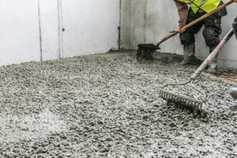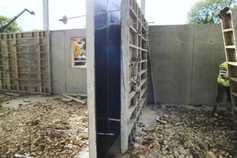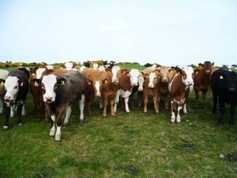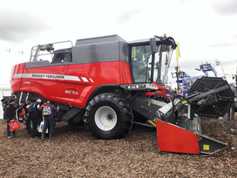This is the lower end of the market but even better deals are being done on larger jobs.
Yet, last week, I talked to one farm building contractor who bought €50,000 worth of concrete in September and paid €73, plus VAT, per metre. I checked with him again this week and he was being quoted €72/€73, plus VAT. This is not the highest; farmers are paying up to €80, plus VAT, for concrete, about €90 including VAT.
There is a geographical pattern. Prices are lowest in Leinster, particularly in counties closer to Northern Ireland. Prices in Munster are a few euro per metre higher and are higher again in western counties. The highest prices are being charged in the Kerry and West Cork areas.
One concrete manufacturer I spoke to last week said that prices were typically €64 to €65, plus VAT, in Tipperary; €70 to €75 in north Cork; €68 to €70 in Limerick and up to €79 in north Kerry.
The variation is related to presence or absence of competition. Manufacturers’ costs vary but, irrespective of that, where there are a number of established manufacturers and they compete actively for business, this is the area where prices are lowest. In counties like Galway, Clare and Kerry, there are relatively few manufacturers and prices are high. There are more manufacturers in Leinster and, here, prices are lower.
The farmer who bought concrete for €58, plus VAT, is located in Kildare and can realistically get quotes from up to five manufacturers. The farm building contractor who is buying large quantities of concrete week in, week out, but paying €73, plus VAT, is in Co Clare and has a choice of two manufacturers.
||PIC2||
The difference on a typical farm shed is considerable. A four-bay 30ft shed with tank, lieback and feed apron will use 100km of concrete, as shown in Table 1. Where the difference is €15 per tonne the difference on the entire project is €1,500.
A rule of thumb is that the cement and aggregates for concrete cost €38 to €42 per cubic metre (excluding VAT). That leaves the balance of the selling price to pay for plant, lorries, diesel, staff and other overheads and, hopefully, a profit margin. A busier plant would aim to spread its overheads over more cubic metres of concrete. This is partly why prices are lower in some areas.
With haulage costs rising, the cost of aggregate now accounts for a lower portion of the overall cost of a cubic metre of concrete. Material costs per cubic metre break down as:
Cement: €28 to €32
Aggregate: €8 to €12
Cement costs approximately €100 per tonne and the Department of Agriculture specification for 35N concrete requires 300kg of cement per cubic metre of concrete. Sand and gravel are included at a rate of 750kg and 1,000kg per cubic metre, respectively.
Washed sand costs about €13 per tonne to buy in, while stone costs €10 per tonne. Standard 35N concrete (not meeting the Department of Agriculture farm specification) typically has slightly lower cement and sand contents. Meanwhile, the Department specification for 40N concrete requires 350kg per cubic metre.
Some manufacturers still have their own supply of sand and aggregate. Once, this gave a significant cost advantage. However, with sand and gravel pits competing for business, this is no longer the case.
Committee
A new specification is being considered by a committee led by the Department and with representation from industry, Teagasc and universities. Among the items being considered are:
Whether a third specification is needed. The present system of two has the benefit of simplicity for manufacturers.
Use of higher cement content for most adverse situations, e.g. silage pits. Presuming good workmanship, this would prolong the working life of silage slabs. However, increasing the cement rate makes concrete more difficult to work on site and more at risk of being watered down.
Use of GGBS cement. From a farmer’s point of view, there is evidence that it is more resistant to acid attack and it is slightly cheaper than Portland cement but, at higher inclusion rates, it makes concrete quicker to harden, which can make pouring tricky.
Use of fibres.
Self-compacting concrete.
The Department of Agriculture is reviewing its key specification for farm concrete. The existing spec is in place since 2004 and has served farmers well. It lays down specifications for just two concrete types: 35N and 40N.
The key difference between the two is cement inclusion rate. The 35N spec requires 300kg per cubic metre, the 40N requires 350kg. This issue is key because cement is the single biggest cost item in concrete and because of the large effect inclusion rate has on eventual performance, all other things being equal.
The specifications also regulate the amount of water added. Obviously, the use of more water will make the concrete easier to pour and work but will affect strength. It sets a maximum aggregate size of 20mm.
Larger stones could perhaps come cheaper but could get caught in reinforcing mesh and make the top surface more difficult to lay smoothly. It is not a hardness issue as good quality stone has a crushing strength equal to 60N to 70N.
Where concrete will be in contact with silage or cattle effluent, 40N is used. Its higher cement content is better able to resist the corrosive effects of these substances. For other farm uses, 35N is used.






 This is a subscriber-only article
This is a subscriber-only article











SHARING OPTIONS: